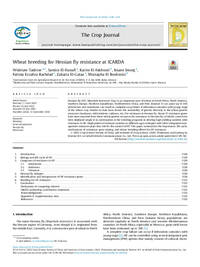Wheat breeding for Hessian fly resistance at ICARDA

Authors:
Hessian fly (HF), Mayetiola destructor (Say) is an important pest of wheat in North Africa, North America, Southern Europe, Northern Kazakhstan, Northwestern China, and New Zealand. It can cause up to 30% yield losses and sometimes can result in complete crop failure if infestation coincides with young stage of the wheat crop. Studies to-date have shown the availability of genetic diversity in the wheat genetic resources (landraces, wild relatives, cultivars, etc.) for resistance to Hessian fly. About 37 resistance genes have been reported from these wheat genetic resources for resistance to Hessian fly, of which, some have been deployed singly or in combination in the breeding programs to develop high yielding varieties with resistance to HF. Deployment of resistant varieties in different agro-ecologies with other integrated management measures plays key role for the control of HF. This paper summarizes the importance, life cycle, mechanisms of resistance, gene mining, and wheat breeding efforts for HF resistance.
